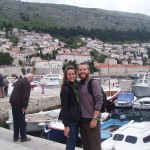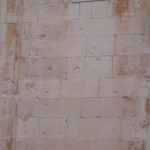Note: Sorry to miss last week’s post! If you are just jumping into the “Travel as Pilgrimage” series, here is a link to the intro blog. Otherwise click the link on the right column for all the posts.

Tucked close to its neighboring countries of Bosnia, Serbia, Montenegro and lining the coast of the Adriatic Sea, Croatia is one of the most beautiful countries I have ever been. When Jan and I arrived in Dubrovnik – Croatia’s most famous city – we knew very little about the country and its people. It didn’t take long for our interests to peak and our worldview to expand as our pilgrimage had inspired so many times before. We really wanted to make our way into Bosnia, which was just 8-10 miles away, but unfortunately we ran out of time.
After joining a guided tour we strolled around the city, which is completely surrounded by massive stone walls which bumps up against the ocean that stretches across to the east side of Italy. The guide, a women in her late 20’s, shared the history of her city with pride. When she got to the events of 1991, things became much more personal for her. In the 1970’s, Dubrovnik completely demilitarized in an attempt to remain at peace. Unfortunately, after declaring independence from Yugoslavia in 1991, it became the target of violence.

Reflecting somberly on the experience, our guide explained that 56% of the buildings were hit by bombings over the course of 7 straight months of attack. She pointed to a nearby hill (See Pic: Bosnia is on the other side) saying that she and her family were in hiding for a year and a half during the war. This was no longer history, it was her reality. She was 12 years old at the start of the violence and said she would look out the window of her hiding place to see the smoke of bombs on a daily basis. (Pic: Walls still had holes from bombings)
At 12 years old, my suffering was not getting the name brand basketball shoes I wanted (I wanted the Reebok Pumps, but had to get the Voit knock-offs…poor me!). Yes, I did have real issues, but none of them were life and death.
Listening to her, I realized there was no way for me to understand the terror of her childhood, but I could choose to grow from the new perspective.
It made me wonder how big my issues would be if I placed them in proper perspective. My world can become so small and revolve around so few people that I begin to believe my issues are much worse than they really are. When put into the perspective of my new friend who had grown up in reality of daily violence, does being 15 minutes late to a “really important’ meeting deserve my frustration, anger and anxiety? Should I really get that bummed out when the Giants lose four straight? How about when that car doesn’t start moving after the light turns green or when the check out line just doesn’t seem to move?
If I fail to look outside my own story, I fail to put my issues in the perspective of humanity. So many of our brothers and sisters around the world haven’t known a day of peace in their lives. May we be thankful for the peace that is offered to us today. May that thankfulness be reflected in our ability to place our story inside the bigger story of humanity and realize things may not be as bad as we make them out to be.